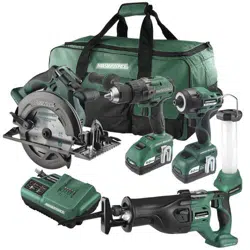Loading ...
Loading ...
Loading ...

Page 16
DRILLING IN WOOD
For maximum performance, use high-speed-
steel bits (available separately) or brad-point
bits (available separately) for wood drilling.
1. When drilling “through” holes, place a
block of wood behind the workpiece to
prevent ragged or splintered edges on
the back side of the hole.
2. Begin drilling at a very low speed to
prevent the bit from slipping off the
starting point.
3. Increase speed as the drill bit bites into
the material.
DRILLING IN METAL
For maximum performance, use high-speed-
steel bits (available separately) for metal or
steel drilling. It’s recommended to use the
impulse mode to drill into steel pipes.
1. When drilling metals, use light oil on
the drill bit to keep it from overheating.
The oil will prolong the life of the bit and
increase the drilling action.The oil will
prolong the life of the bit and increase
the drilling action.
2. Begin drilling at a very low speed to
prevent the bit from slipping off the
starting point.
3. Maintain a speed and a pressure that
allow cutting without overheating the
bit. Applying too much pressure will:
• Overheat the hammer drill
• Wear the bearings
• Bend or burn bits
• Produce off-center or irregularly shaped
holes
DRILLING IN MASONRY
For maximum performance, use carbide-
tipped-masonry bits (available separately)
for masonry drilling.
1. When drilling in masonry, select the
hammer-drilling mode.
2. Drilling soft masonry materials, such
as cinder block, requires little pressure.
Hard materials, like concrete, require
more pressure.
3. A smooth, even flow of dust indicates
the proper drilling rate. Do not let the bit
spin in the hole without cutting. Do not
use water to settle dust or to cool bit.
SCREWDRIVER OPERATION
1. Select the desired speed/torque range
to match the planned operation.
2. Attach the desired fastener accessory
into the chuck.
3. Make a few practice runs in a scrap
piece before working.
OPERATION
Loading ...
Loading ...
Loading ...
